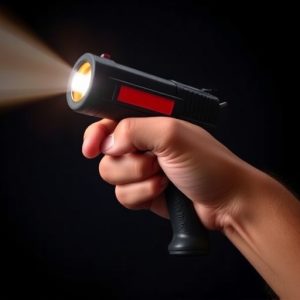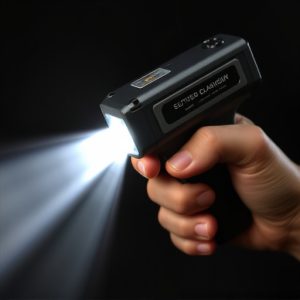Decoding Stun Gun Effectiveness: Mechanics and Real-World Self-Defense Outcomes
Stun guns are non-lethal self-defense devices that deliver high-voltage, low-current electric shock…….
Stun guns are non-lethal self-defense devices that deliver high-voltage, low-current electric shocks to incapacitate an attacker by disrupting neuromuscular function. The effectiveness of these devices is contingent on the battery strength and electrode design, which targets motor nerves to induce painful muscle contractions. Advanced models may include additional safety features like LED flashlights and alarms. To use a stun gun effectively, one must understand how it works: an electromagnetic pulse or electric shock causes rapid and uncontrollable muscle contractions that disorient the attacker without causing long-term harm. The device's efficacy is affected by user skill, distance, and the electrical charge's intensity. It's crucial to deploy a stun gun at the right moment to surprise an assailant for maximum impact, and accurate aiming is essential. Users must also be aware of local laws regulating stun guns and recognize that their presence can act as a psychological deterrent. A comprehensive understanding of how stun guns work, along with knowledge of legal considerations, is key for anyone considering them as part of their personal defense strategy.
When considering personal safety measures, the role of stun guns as a non-lethal defensive tool has become increasingly prominent. This article delves into the mechanics and efficacy of stun guns, providing insightful analysis under the sections “Understanding Stun Guns: The Mechanics Behind Their Capability” and “Assessing the Effectiveness of Stun Guns in Self-Defense Situations.” How do stun guns work to incapacitate an assailant? We explore this question and more, offering a comprehensive look at their practical use for self-defense. Join us as we dissect the science and real-world applications that make stun guns a significant component of personal safety arsenals.
Understanding Stun Guns: The Mechanics Behind Their Capability
Stun guns, often misunderstood due to their colloquial name, are electronic devices designed for self-defense that incapacitate an attacker by delivering a high-voltage, low-current electrical shock. At the core of their functionality lies a battery and a circuit assembly incorporating electrodes. When activated, the stun gun emits an electric current through the assailant’s body, causing neuromuscular disruption. This interruption disrupts the body’s voluntary muscle control, effectively immobilizing the target. The intensity of the shock is directly proportional to the battery power and the design of the electrode array, which can range from a simple two-probe configuration to more complex multi-prob configurations that increase the surface area of contact with the assailant’s body.
Understanding how does a stun gun work involves delving into the science of electroshock therapy. The electrical charge generated by the device targets the motor nerves, causing involuntary muscle contractions that can be quite painful. These contractions are strong enough to disorient and incapacitate an attacker but are generally non-lethal. The effectiveness of a stun gun is contingent upon proper deployment, which includes directing the electrical current towards large muscle groups, such as the torso or thighs, where it can be most effective. Additionally, the design of modern stun guns often incorporates features like LED flashlights and alarms to deter potential attackers even before the device is activated. These additional components not only enhance user safety but also contribute to the overall functionality and capability of the stun gun as a self-defense tool.
Assessing the Effectiveness of Stun Guns in Self-Defense Situations
Stun guns have become a popular tool for personal safety due to their non-lethal nature and ease of use. When assessing their effectiveness in self-defense situations, understanding how a stun gun works is crucial. A stun gun operates by delivering an electromagnetic pulse or a high-voltage electric shock that temporarily immobilizes the target. This device disrupts the body’s muscle control by causing muscles to contract rapidly and uncontrollably, leading to disorientation and incapacitation without inflicting permanent harm.
The effectiveness of stun guns is contingent upon various factors, including the distance from the target, the strength of the electrical charge, and user proficiency. In a self-defense scenario, the initial response time is pivotal; a stun gun’s impact is most potent when it catches an attacker by surprise. The device’s effectiveness also relies on its proper deployment and accurate aiming. It’s important to note that while stun guns can be highly effective in deterring or incapacitating an assailant, their use must always be considered within the legal framework governing self-defense tools in the relevant jurisdiction. Users should familiarize themselves with local laws and regulations before relying on a stun gun for personal protection. Additionally, the psychological impact of brandishing a stun gun can sometimes be as significant as its physical effects, serving as a powerful deterrent in and of itself. Understanding these dynamics is essential for anyone considering stun guns as part of their self-defense strategy.


